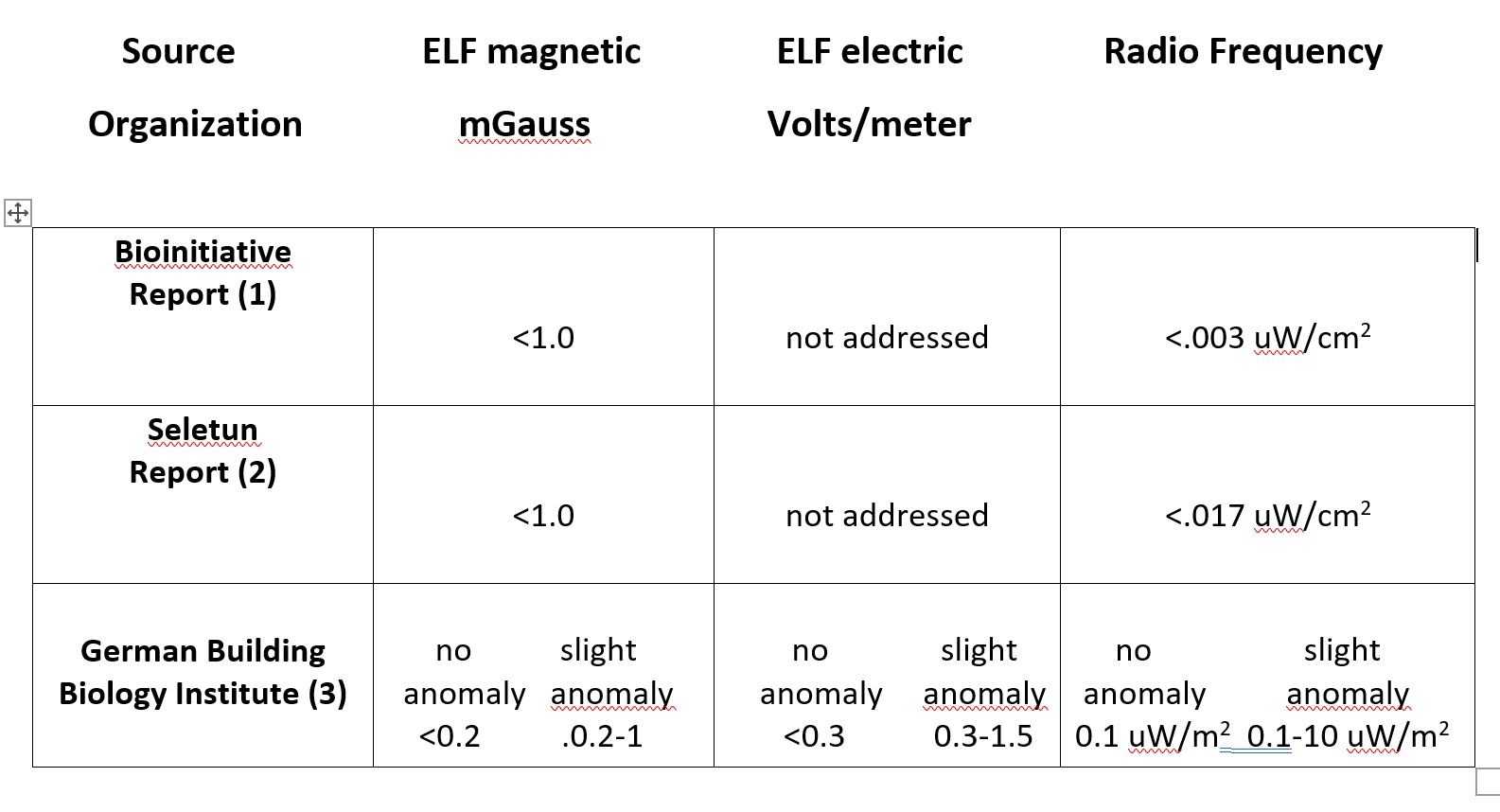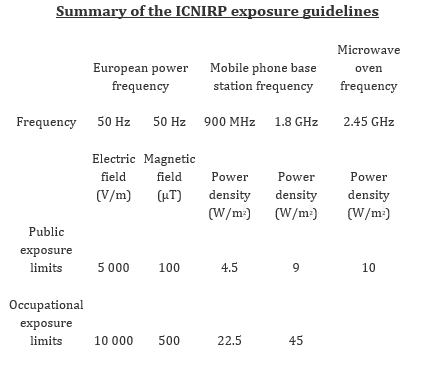EMF EXPOSURE STANDARDS
Do you like what you see on this website? Please help me to continue it.
The small commission I receive when you order products on my site allows me to continue updating it.
Prices are the same as if ordered directly from my affiliates.
Go To EMF PROTECTION PRODUCTS THAT WORK
EMF Exposure Standards
The Bottom Line:
There are no consistent exposure standards for EMF (electromagnetic field) exposure. Some countries have adopted legal EMF exposure standards, other countries have simply adopted suggested exposure limits. Many countries (including the U.S.) only have EMF exposure standards for the industrial workforce and for some electronic devices like cellphones. However, such standards are usually not based on current scientific studies which show damage at much lower exposures than previously recognized.
The table below shows 3 guidelines which have been recommended by certain highly respected groups of scientists. These recommendations have guided the EMF exposure standards adopted by some countries in the world. All are based on careful evaluation of recent scientific studies on the biological effects of EMFs. The suggested exposure limits are very low and based on the precautionary principle: “When an activity raises threats of harm to the environment or human health, precautionary measures should be taken even if some cause and effect relationships are not fully established scientifically.” (Wingspread Conference on the Precautionary Principle - 1998)
TABLE 1 - EMF EXPOSURE RECOMMENDATIONS

(1) 2012 - Lowest observed effect level based
on 1,800 studies reviewed by 29 independent scientists and experts from 10
countries. see Bioinitiative 2012 Conclusions
(2) 2009 Selentun Scientific Panel of 7 scientists representing 5 countries. The scientists are recognized experts in EMF research. see Selentun Scientific Statement
(3) 2015 recommendations are for sleeping areas. Used by numerous Building Biology organizations world wide see Building Biology Evaluation Guidelines
ELF means Extremely Low Frequency and is usually used to reference 50 or 60 Hertz electrical power as used in most homes and businesses.
RF means Radio Frequency and generally refers to all frequencies used for wireless communications up to 300 GigaHertz. This includes what are commonly called “microwaves” and “millimeter waves”
For Information on converting units in the table see below.
My opinion is that:
EMF exposure is a significant hazard to health even at levels much lower than what most standards allow.
EMF remediation should strive to lower exposure to as close to the German Building Biology Institute guidelines as is reasonably possible.
Many other organizations and policy makers throughout the world agree. To see a comprehensive list of laws and current EMF exposure standards by country click HERE
The Fine Print
Most adopted EMF exposure standards are based on SAR values (Specific Absorption Rate). Specific Absorption Rate is based on measurements of absorbed emf energy required to produce heat in human tissue. It is given in Watts per Kilogram of tissue (the Watt is the standard electrical unit of power). The assumption here is that radio frequency radiation is only damaging to humans if it produces heat in the tissue – like how a microwave oven heats something by exposing it to concentrated radio frequency radiation. In the case of a microwave oven the frequency used is the same as that used for Wi-Fi routers and many other wireless products (2.4 GHz “microwave” non-ionizing radiation). A microwave oven, however, has reflective surfaces inside to contain most of the radiation inside the oven. In the case of most wireless devices the radiation is projected into the surrounding environment and is used to communicate with other devices.
It has been well established that radio frequency EMF at any frequency has detrimental biological and health effects at far lower levels than the SAR values. Recent studies and peer reviewed scientific articles in prestigious journals have clearly established this fact. (see my page Health Effects – Scientific Studies)
Using SAR values to establish EMF exposure standards is outdated and in my opinion dangerous. Real damage is occurring at much lower levels.
EMF exposure standards tend to have a very wide range of differences depending on the country, thus it is necessary to consider the factors which may influence legislated standards. In other words what are the commercial, political, and consumer influences on decision making. In the U.S for example it is well known that "tech" industries -wireless companies in particular – have strongly lobbied against the establishing of exposure standards. This may explain the reluctance of the government to establish realistic standards to protect the public from EMF overexposure.
Some international exposure standards have been suggested by the IARC (International Agency for Research on Cancer – part of the United Nations World Health Organization). The IARC mission is “to promote international collaboration in cancer research” and to allow “the research findings of the agency to be translated effectively into timely policies for cancer control.” In suggesting standards for public EMF exposure limits the agency has taken a very conservative approach. The agency listed low frequency EMF from power distribution (50 or 60 Hertz) as a class 2b “possible carcinogen” in 2001. They also listed Radio Frequency (30KHz to 300GHz) EMF as a class 2b “possible carcinogen” in 2011. In light of recent studies, a number of scientists are recommending upgrading the classifications to 2a “probable carcinogen”. This would be a major step forward if it happens.
Most EMF exposure standards that have been adopted both by the IARC and various countries are based on the International Commission on Non-Ionizing Radiation Protection (ICNIRP) guidelines. The guidelines are a 34 page scientific document that lays out very detailed recommendations. The exposure levels are very specific to frequency. The research is impressive. You can browse the document by clicking HERE
The ICNIRP recommendations are orders of magnitude higher than those in table 1 above. You may be interested in looking at the World Health Organization guidelines which are based on the ICNIRP by clicking HERE
A table from the document is reproduced below:

Note that the ICNIRP guidelines for public exposure limits for 50 Hz magnetic fields are 100 uT. Converting to mG this would be 1,000 mG (milliGauss). Compare this to TABLE 1 above and you'll notice the Building Biology Institute suggests that biological effects begin to occur at .2 mG -
The ICNIRP guidelines are 5,000 time greater!
What accounts for such a huge difference? In reading the fine print of the ICNIRP guidelines we see that they are based on Specific Absorption Rate (SAR) studies which consider only the heating effects of RF (non-ionizing) radiation on human tissue and the potential for induced (shock level) currents in the body.
So What Level of Exposure is Safe?
The bottom line is: NO ONE KNOWS FOR SURE!
Each individual must decide for themselves what level of exposure you will tolerate.
As a world community we have embarked on a course of "no return". Man made EMF is increasing exponentially as new technologies come online weekly. You must decide if you trust those who proclaim there is no harm from man made EMF or if you believe those who proclaim an EMF doomsday in the near future.
I believe the truth is somewhere in between.
I also believe it is wise to opt for "prudent avoidance" until the facts become undeniable. I am personally trying to get my home as close to the Building Biology Guidelines as possible.
Converting Units
When making field measurements you must know what unit of measurement the meter displays. In some cases, it will be necessary to convert units used on the tables to that read by the meter. The following should be helpful.
To convert milli (m) to micro (u) multiply by 1,000
example: 0.2 m = 200 u (move the decimal 3 places right)
To convert square centimeters (cm2) to square meters (m2) multiply by 10,000
example: .006 uW/cm2 = 60 uW/m2
(move the decimal 4 places to the right)
To convert micro-Teslas to milli-Gauss multiply by 10,000
example: .70 uT = 7.0 mG (move the decimal 1 place to the right)
For a complete discussion of how to take and interpret measurements
please read my e-book
MAKING YOUR OWN EMF MEASUREMENTS
by Gary Bocksch AAS, BS, MS
Purchase Below - now only $19.95